While I'm here in the town of Thanjavur I'm keen to use my weekends to explore this geography for hidden places of interest. A few weeks ago my colleagues and I drove towards the coastal town of Nagapattinam. While driving on a road parallel to the coast we took an arbitrary turn on a whim and drove till we ran out of road, parked our car, hiked through the woods in the direction of the sea and came out to this completely untouched beach. I can't tell you the name of this place because, I suspect, it doesn't have one. We could see long stretches of beach on either side, but in the three hours we spent there we didn't spot a single person apart from the ones in our group.
Our next trip was on bicycles. There is a curious dam in this region, built by Karikalan Chola, called Kallanai, which is said to be the oldest such structure still in use. One of the canals from the reservoir, Pudhu aaru, passes our town. At the point where it crosses national highway 67, there's a road that starts to run right next to the river for nearly 30-40 kms. One on side is the canal and some really old bridges and sluice gates and on the other is unbroken stretches of maddeningly green paddy fields. It will take a lot more visits before I get bored of this one.
The weekend after that one was spent in conventional tourism, a regrettable visit to the Thanjavur palace. Almost everything is wrong with that place. The ground floor has a collection of arbitrarily arranged chola artifacts all mounted on grotesque pedestals. In the frontyard there are eyesores of all kinds, concrete dalmations, plastic elephants, etc. One of the main halls houses several bronze statues from thousands of years ago, but among them are PoP models of the Vailankanni church that makes you wonder what substance the curator was abusing. The upper floor surprises you with a whale skeleton and a tortoise shell mounted on a lamp post. In that way, the museum keeps getting weirder. All along the walls hundreds of couples have professed their love for each other, but amidst all the absurdist drama dished out by the archaeological department, the graffiti is the least of the travesties. Avoid this one!
Tuesday, December 28, 2010
Sunday, December 19, 2010
Life in Thanjavur
Working for a rural healthcare non-profit in a small town, I thought, would lend me enough action during the weekdays and enough time during the weekends in which to blog about them. In my sixth week here I can safely conclude that I was wrong about the latter. In fact, the whole weekend-weekday separation, along with work-life or professional-personal, have all turned out to be a false dualities, and not necessarily in a negative way. Spending evenings and weekends, and even living with, the same people that I see at office all week hasn't been as cloistering as I would have imagined before I got here.
Life in a small town also has thrown the predictable charms my way. The "commute" to work is a 450m walk. When I have to catch a train, I leave home a few minutes before departure time. Eating out is a hard choice between not-more-than-six-or-seven restaurants. Waiters at our regular breakfast joints bring out the coffee and the smiles, in that order, before we have settled down in our seats. Kiosk owners wave at us even if we pass by, and don't bother to come running after us if we forget to pay. Our town also affords us unlimited clean air, and access to some of the prettiest country-sides you can think of.
Yet, Thanjavur is not heaven on earth. My biggest grouse here is the honking epidemic that seems to be gripping the population. Also, it might just be my observation, but the bus-drivers here are among the most maniacal I've seen. While the low traffic volumes on the street seem like a privilege, you can't really take things for granted. As a final reminder that our town is no idyllic paradise, our office was subject to a burglary that made us poorer by a laptop, a TV and half a dozen doors.
On average, though, it's been a fair amount of fun. Details in subsequent posts.
Life in a small town also has thrown the predictable charms my way. The "commute" to work is a 450m walk. When I have to catch a train, I leave home a few minutes before departure time. Eating out is a hard choice between not-more-than-six-or-seven restaurants. Waiters at our regular breakfast joints bring out the coffee and the smiles, in that order, before we have settled down in our seats. Kiosk owners wave at us even if we pass by, and don't bother to come running after us if we forget to pay. Our town also affords us unlimited clean air, and access to some of the prettiest country-sides you can think of.
Yet, Thanjavur is not heaven on earth. My biggest grouse here is the honking epidemic that seems to be gripping the population. Also, it might just be my observation, but the bus-drivers here are among the most maniacal I've seen. While the low traffic volumes on the street seem like a privilege, you can't really take things for granted. As a final reminder that our town is no idyllic paradise, our office was subject to a burglary that made us poorer by a laptop, a TV and half a dozen doors.
On average, though, it's been a fair amount of fun. Details in subsequent posts.
Labels:
thanjavur
Monday, November 15, 2010
And now for something completely different...
A lot has happened in the past fortnight. After spending nearly three and a half years there, I quit Yahoo!, bidding farewell to a lot of good friends, a great team, fat paychecks, nice food, free transportation, diverse lunch-time conversations, Friday evening cricket games and Sunday morning soccer. I do take with me lots of learnings, many friendships and this really thoughtful farewell gift.
Beginning this month, I joined ICTPH to lead the technology roadmap here. I was looking forward to the changes- both professional and locational- with nervous excitement. Bangalore is the only city in India I've called home and I did grapple with doubts about moving to Chennai. The change has been surprisingly smooth. My hosts, with their so-good-they-could-teach-it levels of hospitality, and my office location, overlooking the awesome IIT-Madras campus, have both played a part in easing the transition anxieties.
As it turns out, I will be spending most of my time in the small town of Thanjavur, a little over 350 kms from, and a few years behind, my hometown. I've been doing my best to surround myself with at least a few of my regular kicks; I've transported my car and bicycle, and have got myself acquainted with a basketball court and a watering hole here. Professionally, too, I've stretched my wingspan over a wider range (if not depth) of responsibilities than I'm used to at a given time. As I familiarize myself with the domain, I'm drafting my goals and starting to chart my course. Things will get clearer over the next couple of weeks, but during a meeting with the founders of AirJaldi, I latched on to a sentence that I thought wasn't a bad end to strive for, "You folks are aspiring to do to health what Arvind did to eye-care".
Beginning this month, I joined ICTPH to lead the technology roadmap here. I was looking forward to the changes- both professional and locational- with nervous excitement. Bangalore is the only city in India I've called home and I did grapple with doubts about moving to Chennai. The change has been surprisingly smooth. My hosts, with their so-good-they-could-teach-it levels of hospitality, and my office location, overlooking the awesome IIT-Madras campus, have both played a part in easing the transition anxieties.
As it turns out, I will be spending most of my time in the small town of Thanjavur, a little over 350 kms from, and a few years behind, my hometown. I've been doing my best to surround myself with at least a few of my regular kicks; I've transported my car and bicycle, and have got myself acquainted with a basketball court and a watering hole here. Professionally, too, I've stretched my wingspan over a wider range (if not depth) of responsibilities than I'm used to at a given time. As I familiarize myself with the domain, I'm drafting my goals and starting to chart my course. Things will get clearer over the next couple of weeks, but during a meeting with the founders of AirJaldi, I latched on to a sentence that I thought wasn't a bad end to strive for, "You folks are aspiring to do to health what Arvind did to eye-care".
Saturday, November 06, 2010
Thoughts on the river linking project
When we embraced liberalization in the early 90s we unleashed the collective potential of a billion people. Suddenly, the middle class bulged and we could tangibly feel the quality of our lives improve. We had a realistic chance to materialize any dream no matter how crazy it sounded ( IIPM, for instance). As an offshoot that kind of atmosphere also germinated hubris. There was a belief that no scheme, however outrageous, was impossible.
In such a backdrop a curious solution that has long been touted to solve both our drought and flood issues has gathered new support and grown into a noisy chorus. The contention is this: north India experiences floods and the south faces droughts. Why not link up the river systems so that the water is distributed equally?
I have my reasons for being unequivocally against the idea. River systems and the ecology have co-evolved over millions of years and I'm not confident that we understand enough about them to perform large scale geo-engineering. To take an example, I'm not sure we know enough to predict what will happen to the spawning cycles of goonch or the migration patterns of the gangetic dolphins. Or take the deltas downriver which are in a delicate equilibrium; the river deposits silt and the sea erodes it. How will that change if we go around altering the course of the rivers? Moreover, the northern plains are lower than plateaus down south. It won't be as simple as drinking the last bit of soup; tilt the bowl and make the liquid go where you want it to. Enormous power and numerous big dams will be required to raise the water up over the Vindhyas, Satpuras or the Aravalli. Is it worth it? There will also be that trivial issue of dealing with a few million people being displaced.
But this post is not to discuss the merits of the plan as much as about what I think will be done about the plan. What I've observed is that most people are impressed by the deceptive simplicity of linking rivers. "Why haven't we linked them yet?" they ask, apparently convinced of the unmistakable logic. That argument from personal incredulity suggests a growing consensus and also that the time is ripe for our leaders to make some populist purchase (and make loads of money in the process too) by embarking on the project. Most of our politicians must be itching to cash in on the opportunity. That's why I'm so glad our Environment minister is not a regular politician.
The Environment Ministry has traditionally been a fringe portfolio in most of our governments and is often perceived as a nuisance, a detriment to our dream of joining the first world elite. It must be hard to stand up for the environment when the majority religion among your constituency is Development. Everybody is judging the minister, Jairam Ramesh, to make sure he doesn't slow down our 8% pa sprint. But, repeatedly, the minister has shown that he can stave off that pressure. He has demonstrated that in various issues such as the Gundya Power project, Navi Mumbai airport, Bt Brinjal issue, putting pressure on China, Vedanta projects etc . More than anything I like the way he has shown the river linking proposal the disdain I think it deserves. Through it all, he's encouraged a level of transparency heretofore unseen in an Indian Ministry. I have to agree with my friend, K, when he says that Mr.Ramesh is probably the best environment minister we've had. What's also encouraging is that it took the architect of our economic liberalization, Dr.Singh, to give the environment ministry the importance it needs. It's heartening that the PM understands the need for that counter-weight while being focused on economic growth. Kudos to them both. And leave the rivers alone!
In such a backdrop a curious solution that has long been touted to solve both our drought and flood issues has gathered new support and grown into a noisy chorus. The contention is this: north India experiences floods and the south faces droughts. Why not link up the river systems so that the water is distributed equally?
I have my reasons for being unequivocally against the idea. River systems and the ecology have co-evolved over millions of years and I'm not confident that we understand enough about them to perform large scale geo-engineering. To take an example, I'm not sure we know enough to predict what will happen to the spawning cycles of goonch or the migration patterns of the gangetic dolphins. Or take the deltas downriver which are in a delicate equilibrium; the river deposits silt and the sea erodes it. How will that change if we go around altering the course of the rivers? Moreover, the northern plains are lower than plateaus down south. It won't be as simple as drinking the last bit of soup; tilt the bowl and make the liquid go where you want it to. Enormous power and numerous big dams will be required to raise the water up over the Vindhyas, Satpuras or the Aravalli. Is it worth it? There will also be that trivial issue of dealing with a few million people being displaced.
But this post is not to discuss the merits of the plan as much as about what I think will be done about the plan. What I've observed is that most people are impressed by the deceptive simplicity of linking rivers. "Why haven't we linked them yet?" they ask, apparently convinced of the unmistakable logic. That argument from personal incredulity suggests a growing consensus and also that the time is ripe for our leaders to make some populist purchase (and make loads of money in the process too) by embarking on the project. Most of our politicians must be itching to cash in on the opportunity. That's why I'm so glad our Environment minister is not a regular politician.
The Environment Ministry has traditionally been a fringe portfolio in most of our governments and is often perceived as a nuisance, a detriment to our dream of joining the first world elite. It must be hard to stand up for the environment when the majority religion among your constituency is Development. Everybody is judging the minister, Jairam Ramesh, to make sure he doesn't slow down our 8% pa sprint. But, repeatedly, the minister has shown that he can stave off that pressure. He has demonstrated that in various issues such as the Gundya Power project, Navi Mumbai airport, Bt Brinjal issue, putting pressure on China, Vedanta projects etc . More than anything I like the way he has shown the river linking proposal the disdain I think it deserves. Through it all, he's encouraged a level of transparency heretofore unseen in an Indian Ministry. I have to agree with my friend, K, when he says that Mr.Ramesh is probably the best environment minister we've had. What's also encouraging is that it took the architect of our economic liberalization, Dr.Singh, to give the environment ministry the importance it needs. It's heartening that the PM understands the need for that counter-weight while being focused on economic growth. Kudos to them both. And leave the rivers alone!
Friday, October 01, 2010
Kwaheri Tanzania
Today is my last day in Tanzania. I dine with an American of desi descent and a Bangladeshi from Texas. One of the highlights of this trip is that despite traveling alone I've not had more than a couple of meals by myself. Despite meeting all those people over various lunches and dinners this was the first time I was in desi company and we use the opportunity for some self-effacing desi ribbing. We joke about Kilimanjaro being the only Patel-point without Indians in the crowd. In fact, I was probably the only climber with an Indian passport atop the peak over the 7 days that we were there.

Reliving all the moments from the trip I realize that I've already wrapped my experiences in the finest dreamy shrink-wrap that I reserve for my best memories. They deserve it too; I've had 15 days of endless activity with not a minute of boredom, seen fantastic visuals, photographed 50 new species of birds, had encounters with the some of the most charismatic megafauna on earth, experienced good health including, and this is underrated, timely and regular bowel movements, met lots of interesting new people, made a few friends...Every thing I could have asked for on a trip like this. A lot to say Asante for!

Reliving all the moments from the trip I realize that I've already wrapped my experiences in the finest dreamy shrink-wrap that I reserve for my best memories. They deserve it too; I've had 15 days of endless activity with not a minute of boredom, seen fantastic visuals, photographed 50 new species of birds, had encounters with the some of the most charismatic megafauna on earth, experienced good health including, and this is underrated, timely and regular bowel movements, met lots of interesting new people, made a few friends...Every thing I could have asked for on a trip like this. A lot to say Asante for!
Wednesday, September 29, 2010
Ngorongoro
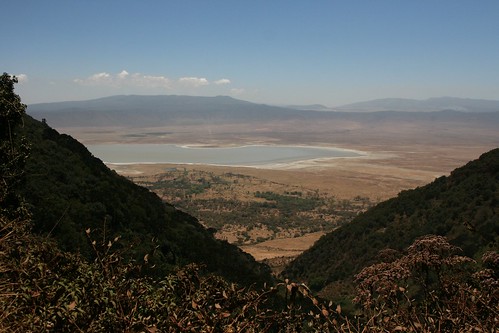
My final day of safari is in the Ngorongoro crater. I learn from my guide that the place gets its name from the sound of the bells of the maasai cattle. This is indeed a fascinating place, like someone cut a circular section of 10 km radius of the Serengeti, intact with all the fauna, and placed it in a petri dish. The 650m high wall that surrounds this crater is in stark contrast to the boundlessness of the Serengeti plains just north of here.

On my safari in the crater I'm looking out for the last of the "Big Five" that I haven't spotted yet, the Rhino. While I'm busy watching out for it, a male lion majestically walks past us ahead of our vehicle. Just a few kms away we see a pride of five lions gorging on a buffalo that was probably killed a few minutes ago. Our third encounter with the lions today happens at the picnic spot where a pride strays into the parking area. One young male settles down in the shade of a safari vehicle. When the vehicle moves forward he follows it and sits back down in its shadow. When the vehicle moves yet again, he urinates on it as if to claim ownership. When the driver refuses to obey that contract, he gives up and walks away looking for a more reliable shadow.
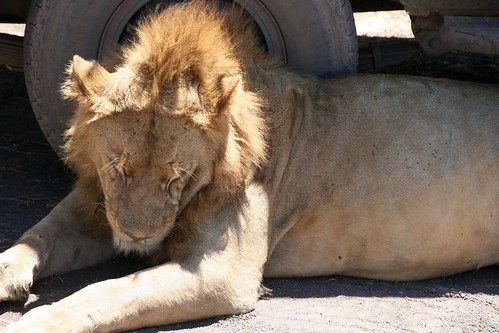
We eventually find the rhinos we are looking for but not from a distance I would have liked. After that little encounter, we drive down to the soda lake and photograph the flamingos before driving off to Moshi.
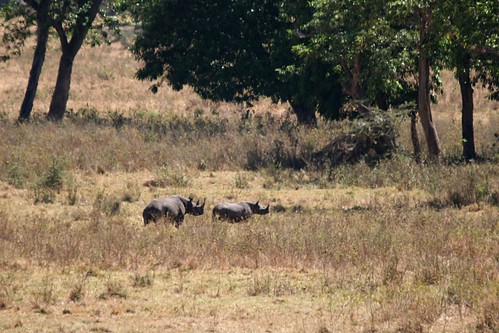
On the drive back it feels different because, for the first time in 5 days, I'm sitting down in the passenger seat with the sun roof lowered down. For the first time in days I'm not straining my eyes to spot wildlife. Nas and I then go on to exchange notes on our respective cultures. He tells me proudly that he is a big fan of bollywood, and that his favorite song is "Mere Naseeb mein" (My only explanation for that odd choice is that his name appears in the lyrics). I have to reciprocate, and so I learn to sing a Swahili song that is something of an anthem in this part of the world.
Jambo, Jambo bwana, Habari Gani, Zuri Sana
Wageni mwakaribishwa, Tanzania Hakuna matata.
We then discussed all the places in Tanzania that I haven't had the time to visit; Tarangire, Mt Meru, Lake Victoria to name a few. The conclusion is simple: I have to visit Tanzania again!
Labels:
tanzania
Tuesday, September 28, 2010
Serengeti
They say that curiosity, as much as devotion, makes a pilgrim, If you spent as much time as me watching films set in the Serengeti conjecturing about what exists outside the aspect ratio of the TV screens you'd understand why this trip is almost spiritual for me.
Serengeti gets its name from Serengit, Maasai for "Endless Plain", which brings me to the whole truth about this place that none of the documentaries or any of my pictures will (or can) tell. It truly is vast and plentiful beyond belief. The drive into the park is so featureless with no undulation, tree or rock, that it can induce land-sickness. The monotony is interrupted by the occasional jackals, gazelles or the Maasai in his red dress watching his herd! The reason nothing grows here is that a volcano deposited ash over the plains and the thin top soil above that layer supports only grass.

Once you are inside the protected area of the park the vast grasslands are dotted by the characteristic acacias and big granites jutting out, called Kopjes. Of course there are animals and birds in numbers and variety that are mind-boggling. (This without the 2 million migratory wildebeest, zebras and buffalos that are spending this season across the border in Kenya).
Wildlife documentaries don't capture the sense of infinity that you feel in Serengeti. They also misrepresent the rhythm of the place. The herbivores go about the business of eating all day. The carnivores range from Lions, which seem to do nothing but sit around, to the hyenas scanning the plains continuously with their busy gait. The hunts that films focus on are infrequent punctuation that I never get to see in the 3 days I spend there. The closest I get to that is this leopard who had brought home a gazelle to eat both for dinner and the following brunch.
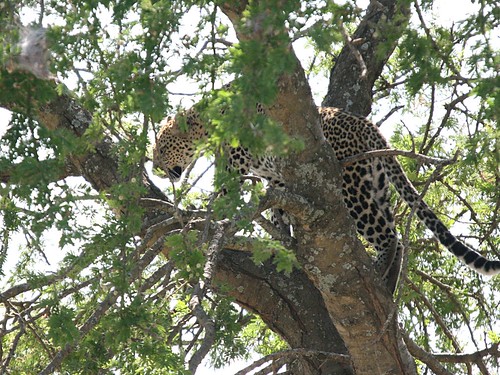
On the second evening I also meet my favorite big cat, the Cheetah. He is at least a hundred meters from my car and he's scanning the horizon for an early dinner. He seems to spot something and starts trotting in that direction. We try to keep pace with him and I notice that we are traveling at nearly 40 kmph. His path diverges from ours and within a minute he's so far that I can't even see him with my binoculars. Having seen his scale of operations here I don't think I can excuse putting a Cheetah in a zoo anymore.
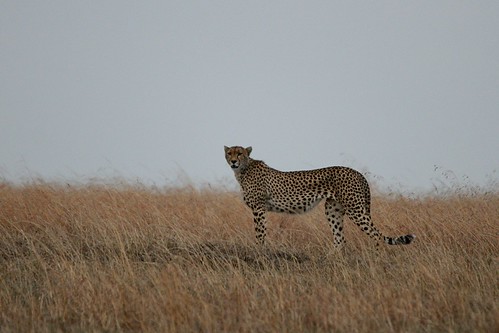
In the two days I spend at the park I see dozens of species of birds, countless ungulates, a male Ostrich getting lucky, a falcon guarding its nest from my intrusions, countless lions, and many more. The safari doesn't end when we get back to the camp, because our tents are right out in the open and we are visited by wildlife at night. On the second morning I see a Zebra just outside my tent and a few minutes later hear a Hyena not more than a few meters away.
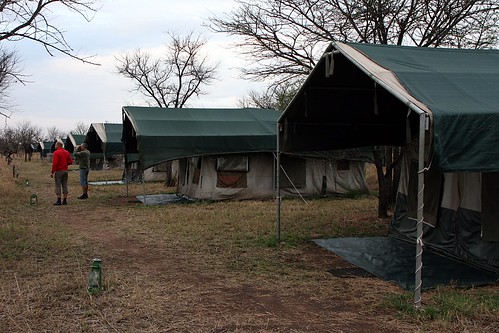
On the third morning we drive off to visit Ngorongoro, and on the way out I try to drink everything in. Three days haven't left me accustomed to the vastness of this land and I'm left with that feeling that characterizes all pilgrimages, that feeling of sacred awe.
Serengeti gets its name from Serengit, Maasai for "Endless Plain", which brings me to the whole truth about this place that none of the documentaries or any of my pictures will (or can) tell. It truly is vast and plentiful beyond belief. The drive into the park is so featureless with no undulation, tree or rock, that it can induce land-sickness. The monotony is interrupted by the occasional jackals, gazelles or the Maasai in his red dress watching his herd! The reason nothing grows here is that a volcano deposited ash over the plains and the thin top soil above that layer supports only grass.

Once you are inside the protected area of the park the vast grasslands are dotted by the characteristic acacias and big granites jutting out, called Kopjes. Of course there are animals and birds in numbers and variety that are mind-boggling. (This without the 2 million migratory wildebeest, zebras and buffalos that are spending this season across the border in Kenya).
Wildlife documentaries don't capture the sense of infinity that you feel in Serengeti. They also misrepresent the rhythm of the place. The herbivores go about the business of eating all day. The carnivores range from Lions, which seem to do nothing but sit around, to the hyenas scanning the plains continuously with their busy gait. The hunts that films focus on are infrequent punctuation that I never get to see in the 3 days I spend there. The closest I get to that is this leopard who had brought home a gazelle to eat both for dinner and the following brunch.

On the second evening I also meet my favorite big cat, the Cheetah. He is at least a hundred meters from my car and he's scanning the horizon for an early dinner. He seems to spot something and starts trotting in that direction. We try to keep pace with him and I notice that we are traveling at nearly 40 kmph. His path diverges from ours and within a minute he's so far that I can't even see him with my binoculars. Having seen his scale of operations here I don't think I can excuse putting a Cheetah in a zoo anymore.

In the two days I spend at the park I see dozens of species of birds, countless ungulates, a male Ostrich getting lucky, a falcon guarding its nest from my intrusions, countless lions, and many more. The safari doesn't end when we get back to the camp, because our tents are right out in the open and we are visited by wildlife at night. On the second morning I see a Zebra just outside my tent and a few minutes later hear a Hyena not more than a few meters away.

On the third morning we drive off to visit Ngorongoro, and on the way out I try to drink everything in. Three days haven't left me accustomed to the vastness of this land and I'm left with that feeling that characterizes all pilgrimages, that feeling of sacred awe.
Labels:
tanzania
Sunday, September 26, 2010
Lake Manyara

I start my tanzanian safari with a visit to Lake Manyara. I have a Toyota Landcruiser all to myself. Feel bad about being the lone passenger in a huge vehicle but secretly appreciate the freedom too, because folks - even friends - don't take too kindly to stopping for every bird. Nasibu, my driver and guide, tells me that they picked him because he is the most knowledgeable about birds. He uses our journey time to give me an introduction to Tanzanian culture. He is very proud that 120 tribes live in perfect harmony. I like that; it's harder to be fiercely proud of being peaceful than , say, of being a courageous warrior clan.
Manyara offers me good practice for the biggies that I am scheduled to visit over the next four days. On the way out of the park we come across a Silvery Cheeked Hornbill feeding her "captive" female through a narrow slit in the nest. I had always heard about their strange nesting/breeding habits, and this time I got to experience it from up close.
Labels:
tanzania
Saturday, September 25, 2010
Day 7 - Back to Moshi
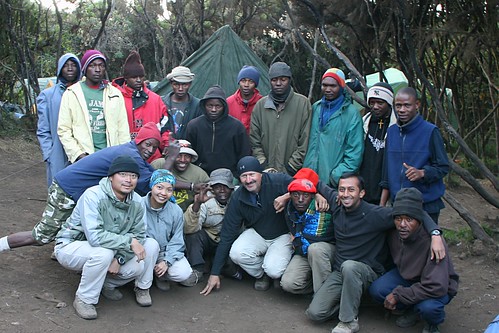
The descent down the east face of the mountain is about as boring as it gets, especially after the fantastic views that the rest of the Machame route threw at us. There's nothing much I have to say about the trail, but the highlight for the day was the song and dance that we had with the staff this morning after breakfast.
If days 1 to 6 were all about conquering the peak, day 7 was about hurtling down the hill as fast as I could so that I could hit the shower and be human again. The afternoon was dedicated to reliving the memories from the trip. Everybody's experience of the journey is different. Everybody's experience is the same. There was a lot of joy to have made it to the top. There was a lot of happiness to be back in civilization.
We - Warren, Kea gang and I, apart from a few other folks we met on the trek - decided to celebrate our success by spending time together tasting the night life of Moshi. We hit a club called Glacier that employs the absolute worst DJ in the world. He played a mix of songs that had no business being together. He would stop the songs at the oddest places, forcing the dancers to pause mid-air, look around embarrassed, and then untangle themselves from the dance moves they had been forced to pause in. But no incompetent DJ could dampen our spirits. We laughed and smiled and danced and sang, and we knew, whether we meet again or not, we were never going to forget each other or the seven days we spent together
Labels:
kilimanjaro
Friday, September 24, 2010
Day 6 - Summit!
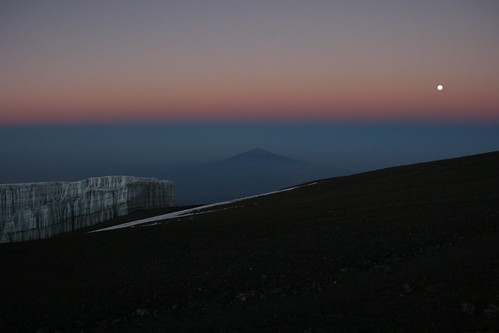
I knew from all accounts that day 6 was going to be tough but hadn't thought I'd be doing the hardest thing I've ever done. We began the hike at a little before midnight under the most brilliant moonlight. It sure was dreadfully cold, but the excitement of scaling the summit kept us from noticing the frigid temperatures and we marched on with loud fervor. After an hour's walk we could see the shining peak that gives the mountain its name; kilima for mountain, jaro for shining. The guides were making vuvuzela noises with their mouths almost to suggest that the celebrations could begin already. Until that point, it seemed like yet another stroll in the park just as the previous 5 days had been, but that optimism was short-lived. After about 3hrs of walking a lot had changed; the weather got harsher - the temperature was 10 below zero - and the terrain got frustratingly hard to navigate because we were walking on a gravel slope that slid us back a step for every two we took forward. By now, the water in my bottle was too cold to be ingestible and I didn't drink anything for the next 3 hours.
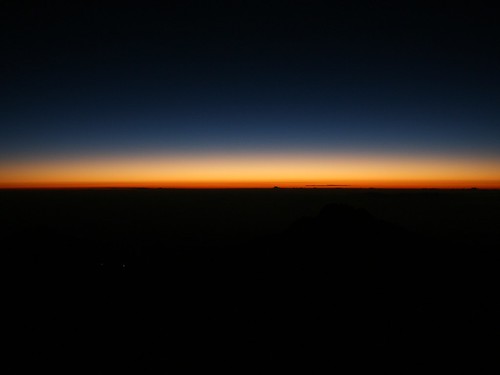
The exhaustion crept up on me almost unnoticed and strangely it was all mental. Sleep deprivation, hunger, dehydration and high altitudes; that's a terrible mix. I was even hallucinating mildly. I distinctly remember thinking that it was a great idea to take a 10min nap while walking. Later, I learned that a lot of people felt drugged while they approached the top. I was continuously telling myself to take it one step at a time. I tried to make small talk with my teammates but nobody was in the mood to indulge me. It was nearly 6 AM when we reached the crater rim to a place called the Stella Point. Now, the peak was a little over a kilometer away but even that distance seemed overwhelming. Richie served us some tea that refreshed me instantly. Despite losing its warmth before I could lift the cup up for a second sip, the tea encouraged us to get going again. Besides, the cold was really punishing inactivity. We trudged along on the ridge and the sun was peeping out of the horizon behind us, spilling some unreal colours on the skies. When I reached the Uhuru peak at 5895m it wasn't like I imagined it. There was no tumult. I felt relief and only relief.
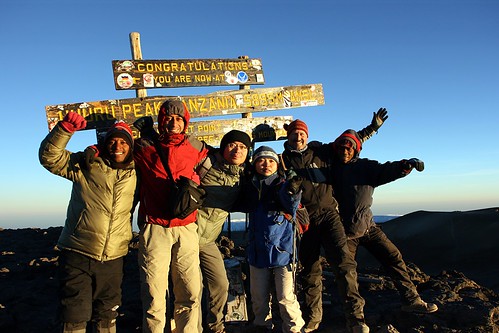
By the time we were done with the pictures there was a nice warm sun. The gravel slopes that had made the climb so irritating made the descent equally easy because we pretty much skied down the gradient. I was still only sleep walking and I didn't feel great, but the thought of reaching the camp made it easy to shut my mind to all negativity and I kept gliding down. Even after I got to the camp at around 10, I was telling myself that all the exhaustion was only in the mind. The body replied in the negative immediately. The retching that began then didn't stop even after every bit of solid or liquid I had consumed had been thrown out. Richie immediately ordered me to start walking to a lower camp. I left the team behind and started walking down at a comfortable pace, stopping only for some violent empty retching. I reached the lower camp, Mweka (3100m), and almost miraculously felt completely back to normal. Only, after walking for nearly 14 hrs without any nutrition or fluid, I felt like I could eat anything I could lay my hands on. The taiwan-made green-tea-flavored oat meal that Sin gave me is a snack that I will never ever forget. The early dinner that evening was special not least for the Kilimanjaro beer that Richard served us. At the end of the meal I finally felt human. I finally felt what I thought I'd experience on the peak, that flooding sense of accomplishment.
Labels:
kilimanjaro
Thursday, September 23, 2010
Day 5 - Barafu Camp
Woke up on day 5 after an almost sleepless night thanks to two visits to the bathroom, directly attributable to the millet porridge I had enthusiastically consumed during dinner. Each visit involved 15mins of procrastination, 10 mins spent in wearing additional layers of clothing, 5 actually going through the motions in the freezing midnight air, and 10 mins more waiting for the sleeping bag to get warm and snug again.
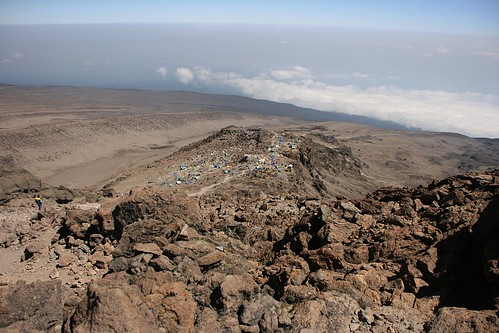
The fifth day's hike took us to Barafu camp at 4650m. Since the hike for that day was short, Warren and I decided to go up another 1200 ft just to reassure ourselves that we were holding up well in the thin air. When we got back there was a definite buzz in the camp as all the porters were busy packing up to split from us. We would meet them again only at the next camp. On the other hand the hikers were discussing about how they feel for the next day's ascent. There was a sense of anticipation hanging over the camp like a dark rain cloud. We couldn't see the peak from the camp but we knew she was just around the bend. Part of me couldn't wait for the rush of the final charge to the summit. Part of me wanted the suspense to end quickly. Part of me just wanted to get back to the world of comfortable beds, clean fingernails and climate-proof shelters

The fifth day's hike took us to Barafu camp at 4650m. Since the hike for that day was short, Warren and I decided to go up another 1200 ft just to reassure ourselves that we were holding up well in the thin air. When we got back there was a definite buzz in the camp as all the porters were busy packing up to split from us. We would meet them again only at the next camp. On the other hand the hikers were discussing about how they feel for the next day's ascent. There was a sense of anticipation hanging over the camp like a dark rain cloud. We couldn't see the peak from the camp but we knew she was just around the bend. Part of me couldn't wait for the rush of the final charge to the summit. Part of me wanted the suspense to end quickly. Part of me just wanted to get back to the world of comfortable beds, clean fingernails and climate-proof shelters
Labels:
kilimanjaro
Wednesday, September 22, 2010
Day 4 - Karanga Camp

On the fourth morning, we scaled the wall to reach the highest point thus far on the hike, 4200m. The route from Barranco wall to Karanga camp includes a lot of alternating climbs and descends which offered good opportunities for acclimatization. The trail wasn't throwing any challenges so I decided to spend my energy picking up swahili, starting with the greetings Jambo (hello), Kwaheri (goodbye), Asante (Thanks), Karibu(welcome). Since Tanzania has the kind of culture in which strangers greet each other if they as much as make momentary eye contact, I got a lot of practise using the phrases I learnt, unleashing them on every porter who passed us. I also learnt that the porters prefer to be called Wagumu (strong men).

From the Karanga camp the summit looks deceptively accessible. Karanga is also the last camp with the water source. From here, water is a scarce commodity and there was intense activity in the camp with all the porters scampering around collecting water for the next camp, Barafu, from where we were to make the final summit assault.
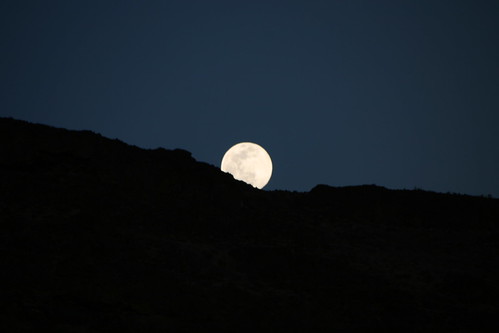
Finally, the moon just keeps getting better with each passing night.
Labels:
kilimanjaro
Tuesday, September 21, 2010
Day 3 - Barranco camp
To sum up day 3, we walked a distance of 13km in 7 hrs for an overall gain of a mere 100 m in altitude. The purpose of that was to acclimatize the hikers to the high altitudes. This leg of the journey has some stunning views of the mountain and the valleys, including a curious geographical formation called the Lava Tower at 4590 m.

I happened to spot a beautiful sunbird on the way to our camp. Janine, from South Africa, who happened to be walking with me at that time identified it as the Malachite sunbird. She told me about her husband, Jacques, who she said was carrying a birding guide for this region and could validate her identification. I casually mentioned to her that I'd like to take a look at the book to put names against all the other unknown birds I had photographed so far. Later in the evening, the couple were nice enough to track my tent down in the crowded encampment and we ended up having a really long chat over at our dinner tent.

By this time Warren and I had been inducted into the prestigious Kea gang. Following the tradition of that clan, we had been blessed with nicknames; mine was 'Birdman' because I stopped to photograph every bird I met, and Warren's was 'Inspector Gadget', after the gazillion instruments he carried, including a device that uploaded his GPS location to a remote server every 15 mins. Jacques was to earn the moniker 'The Real birdman' in an apparent slight to me, because he carried a field guide in his pocket and I didn't. Here he is with his wife Janine.

The camp was next to a 1000ft near-vertical rock face called the Barranco wall. The camp was at an altitude that seemed to be make-or-break for a lot of people, as we heard continuous retching through the night. It's bad enough that they retched, but to have it played back to them as an echo from the neighbouring wall provoked a few muffled laughs. I must say I found it funny too. Exactly two days from then I was to find out that there's nothing remotely funny about throwing up.

I happened to spot a beautiful sunbird on the way to our camp. Janine, from South Africa, who happened to be walking with me at that time identified it as the Malachite sunbird. She told me about her husband, Jacques, who she said was carrying a birding guide for this region and could validate her identification. I casually mentioned to her that I'd like to take a look at the book to put names against all the other unknown birds I had photographed so far. Later in the evening, the couple were nice enough to track my tent down in the crowded encampment and we ended up having a really long chat over at our dinner tent.

By this time Warren and I had been inducted into the prestigious Kea gang. Following the tradition of that clan, we had been blessed with nicknames; mine was 'Birdman' because I stopped to photograph every bird I met, and Warren's was 'Inspector Gadget', after the gazillion instruments he carried, including a device that uploaded his GPS location to a remote server every 15 mins. Jacques was to earn the moniker 'The Real birdman' in an apparent slight to me, because he carried a field guide in his pocket and I didn't. Here he is with his wife Janine.

The camp was next to a 1000ft near-vertical rock face called the Barranco wall. The camp was at an altitude that seemed to be make-or-break for a lot of people, as we heard continuous retching through the night. It's bad enough that they retched, but to have it played back to them as an echo from the neighbouring wall provoked a few muffled laughs. I must say I found it funny too. Exactly two days from then I was to find out that there's nothing remotely funny about throwing up.
Labels:
kilimanjaro
Monday, September 20, 2010
Day 2 - Shira Camp
The second day on the trek was a relatively relaxed walk - about 7 km to a camp called Shira. This leg of our hike took us out of the tree line and into what they call the moorland.
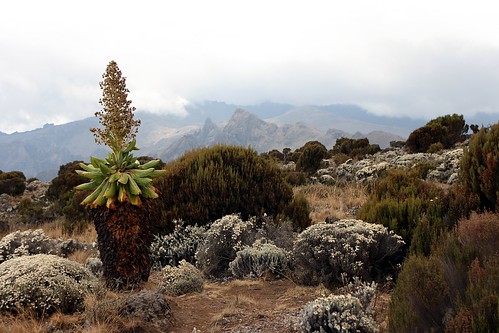
The groups had spread out a little and it didn't seem as crowded as on the first day. After we reached the Shira camp, since we had a lot of energy left, we decided to trek up another little hill. We were rewarded with some fantastics vistas of the mountain. First the moon rose just over the peak and then the setting sun splashed some fancy colours on the mountain.
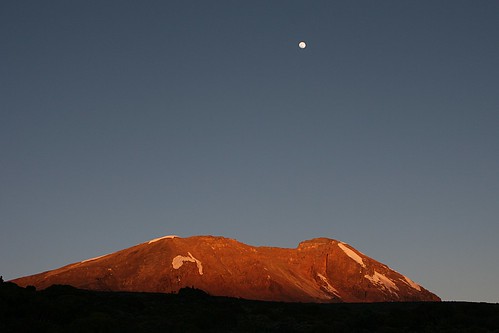
This camp situated at 3850m amsl claimed the first victim; Josy fell rather ill and decided that she couldn't go on any further. Sad to see her go.

The groups had spread out a little and it didn't seem as crowded as on the first day. After we reached the Shira camp, since we had a lot of energy left, we decided to trek up another little hill. We were rewarded with some fantastics vistas of the mountain. First the moon rose just over the peak and then the setting sun splashed some fancy colours on the mountain.

This camp situated at 3850m amsl claimed the first victim; Josy fell rather ill and decided that she couldn't go on any further. Sad to see her go.
Labels:
kilimanjaro
Sunday, September 19, 2010
Day 1 - Machame Hut
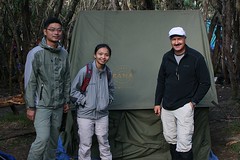
I met the group that I was going to be trekking with; a sweet couple from Hong Kong, Karl and Sin, and Warren from USA, who would come to collect such epithets as "Inspector Gadget", "Mr.Colorado" and "The fittest 46yr old I know!". We also met our guide, Richard a.k.a Richie, whose big smile was to be one of the hallmarks of the trip.
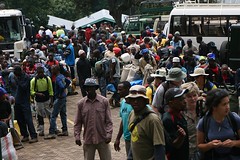
We reached the base camp and found a whole carnival in action. 361 hikers had signed up to start this trek this particular day. Kilimanjaro trail is a popular one, but this was a record and the registration desk at the base camp was ill-prepared to handle the crowd. It was lunch time before the procedures were complete and we were set to go. We popped in our packed lunch boxes and set off into the equatorial forests that cover the base of Kilimanjaro. On the way we met five kiwis who called themselves the Kea tribe; Bridie, Veronica, Rory, Josy and Tess would turn out to be a major source of fun for all of us.
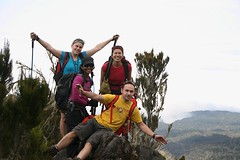
We reached the Machame Hut (2900m amsl) by dusk after walking about 12km. To accommodate the unusually high number of hikers even pathways were taken up for tenting and the place looked not unlike a section of Dharavi. When I snuggled into my sleeping bag after dinner it felt comfortably warm. That was a little worrying because the outside temperature was 17 Celsius and my tent and sleeping bag were going to be put to the test at harsher conditions very soon. But there was time to worry about that tomorrow.
Labels:
kilimanjaro
Saturday, September 18, 2010
Arriving in Moshi

On every holiday I look forward to doing some thing(s) for the first time. This vacation began with one of them when I boarded an Ethiopian Airlines flight. (My childish fascination for novelty aside, apart from the totally unintelligible flight announcements, the experience was like on any other airline.) My flight took me from Bangalore through Mumbai, Addis Ababa, and Nairobi before finally spitting me out at Kilimanjaro airport, a cozy one-runway setup just outside the town of Moshi, Tanzania. There was a sense of bonhomie in the plane on the last leg of the journey because everyone left in the flight was there to do the same thing, climb Mt. Kilimanjaro. The pilot informed us when we flew next to the mountain, but on that particular day Kili was in hiding and you could tell the pilot wasn't lying only from an enormous bump in the cloud cover.
Kilimanjaro dominates everything in this part of the country, not just the landscape. You get Kili-branded stickers, t-shirts, caps, beers and what not. There's even, and I'm not making this up, a CD titled the top 10 songs on the Kilimanjaro!.
We checked in at a hotel called the Uhuru hostel. Uhuru is the name of the highest point on Mt. Kilimanjaro. See what I told you about everything having the Kili flavour? I had dinner with an English couple and hit the sack early full of anticipation for the following day.
Labels:
kilimanjaro
Thursday, September 16, 2010
Off to Kilimanjaro

Picture source.
Ok. I'm a total todo-list junkie. For as long as I can remember I've had various "Things to do before I turn X" lists. Although a lot of people seem to think that that's a terribly unspontaneous way of living life these lists have their use because I seem to get a few things done (except for those items that begin with the words "Get married to..."). One of the things that I had resolved to do before I turn 32 is to climb Mt.Kilimanjaro and now I'm all set! No more updates on this blog till I'm back on Oct 2.
Technically I'm a little late with this task because I already turned 32 last week. Yeah, 32, that little turning point in life after which the main ingredient, by weight, of your birthday cake is wax! And here's a picture of the pyre that my sweet friends set up for me at midnight. Folks, next time, bring an extinguisher too.
More later, with stories from Tanzania.
Labels:
kilimanjaro
Sunday, September 12, 2010
What's trending in the auto-wisdom scene?
Love is. Especially the unrequited kind. Here's the previous one in the series.
Labels:
autos
Monday, August 30, 2010
Mobilicity 2010 - Commuter Rail for Bangalore
The focus of this year's Mobilicity was this fantastically researched and detailed Commuter Rail proposal by IDS and the other folks at Praja. This morning's discussion included common citizens, elected representatives, bureaucrats from the likes of Railways, Metro and BMRDA, and academicians focused on urban issues and sustainability. This gives me real hope. This, to me, is what citizen activism should be all about!
Labels:
mobilicity
Tuesday, August 24, 2010
Blame it on the boys' school
I have a theory that men who studied in boys-only schools tend to be, on average, a little more competitive at sports than others. In school, I was obnoxiously competitive at football and ended up pissing off bigger guys, not a good idea considering my slight build. Retaliations had involved spilling of blood (mine usually)- and I don't mean that metaphorically. To this day, even when the setting is idyllic Goa, beach football games involving my school friends and me contain a lot of posturing, jeering, and sledging, and the trash-talking only stops when it's time to start drinking again. In the cricket games we play at work, I secretly relish the bitter rivalries and provocative matchups- Northies vs. Southies, Dev vs. QA, etc.. I've convinced myself that aggression on the sports arena has a purpose. All that wasted testosterone keeps us from waging real wars, I believe.
Yet in later life, I've tried hard to rein that instinct in because outside of boys' schools equanimity is rated rather highly. I have been fairly successful in staying detached while playing any sport. However, chronic afflictions have a way of showing up every so often, like when I play Settlers of Catan with my friends I can't help making a rat-race out of it. I notice that in the real world cutthroatiness is met with clique-ry, mass resistance, and sometimes. elaborate displays of sabotaging one's own games. Our contests, then, usually descend into a game of proving how little we care about Settlers of Catan. And I want to win that game too! Quick, I need some zen.
Yet in later life, I've tried hard to rein that instinct in because outside of boys' schools equanimity is rated rather highly. I have been fairly successful in staying detached while playing any sport. However, chronic afflictions have a way of showing up every so often, like when I play Settlers of Catan with my friends I can't help making a rat-race out of it. I notice that in the real world cutthroatiness is met with clique-ry, mass resistance, and sometimes. elaborate displays of sabotaging one's own games. Our contests, then, usually descend into a game of proving how little we care about Settlers of Catan. And I want to win that game too! Quick, I need some zen.
Tuesday, August 17, 2010
Listening to Grasshoppers
While the dust from the Meter Jam debate is only just settling, I happened to read this passage from Arundhati Roy's "Listening to Grasshoppers". For those of us familiar to her dogma (and she's never subtle about its dissemination) she unwaveringly bats for the folks that "development" has left behind. She points us to the peace-time collateral damage that the middle class has learnt to ignore. And this extract made a lot of sense in the context of the recent debates:
"Ironically, the era of the free market has led to the most successful secessionist struggle ever waged in India - the secession of the middle and upper classes to a country of their own, somewhere up in the stratosphere where they merge with the rest of the world's elite. This Kingdom in the Sky is a complete universe in itself, hermetically sealed from the rest of India. It has its own newspapers, films, television programs, morality plays, transport systems, malls, and intellectuals. And in case you are beginning to think it's all joy-joy, you're wrong. It also has its own tragedies, its own environmental issues (parking problems, urban air pollution), its own class struggles... This India has its own People's Movements and candlelight vigils (Justice for Jessica, the model who was shot in a bar) and even its own People's Car. It even has its own dream that take the form of TV advertisements in which Indian CEOs (smeared with Fair and Lovely) buy international corporations, including an imaginary East India Company. They are ushered to their plush new offices by fawning white women (who look as though they're longing to be laid, the final prize of conquest) and applauding white men, ready to make way for the new kings. Meanwhile the crowd in the stadium roars to its feet (with credit cards in their pockets) chanting 'India! India!'"
When I started reading "Listening to Grasshoppers", I gave the author a hard job by already picking up a bias, thanks to this review that I had read a few weeks ago.
I confess that I'm settling somewhere left of center in my own political beliefs and Roy did test me. I see the need for a matured democracy and a responsible form of capitalism and so I cringed while Roy unapologetically attacks both those ideals. She sets her tongue on fire and lashes it about wildly. Even when she uses humour it's not to lighten anything. I labored on despite these put-offs because she takes up issues that have always left me with a lot of questions - plebiscite in Kashmir, naxalism, Afzal Guru, Narendra Modi- and represents the side of the issue that has been completely abandoned in the debates in the mainstream media. I gradually started to get convinced of her intellectual honesty in her treatment of the Kashmir issue, as her question whether India needs independence from Kashmir more than the other way around really lingered (not unlike the pitch in this classic). I was finally won over in the title essay in which, in a speech delivered in Turkey no less, she likens the Turkish treatment of their Armenian minority to the Muslims in Gujarat. This book is worth a buy for that essay alone.
In sum, I can't help feel that she would be a lot more useful to the people that she lends her voice to if she could only remain objective at all times, and if she deigns to occasionally acknowledge that not everything is black or white. By continuously spitting venom at the establishment she becomes easy to dismiss. If she only tried to educate and enlighten rather than confront I'm sure she'll land herself a lot more converts. At several points in the book I kept wishing that she stops frothing at the mouth and ventured some real solutions. Yet, she's vitally important, not least as a counterweight to the idiocy that someone like Arnab Goswami can preach from his pulpit. I'm proud that this system that she so vengefully condemns, despite all its flaws, lets her be openly heretic. She's, for me, the canary in the coal mines. As long as you hear her sing, everything's not lost.
"Ironically, the era of the free market has led to the most successful secessionist struggle ever waged in India - the secession of the middle and upper classes to a country of their own, somewhere up in the stratosphere where they merge with the rest of the world's elite. This Kingdom in the Sky is a complete universe in itself, hermetically sealed from the rest of India. It has its own newspapers, films, television programs, morality plays, transport systems, malls, and intellectuals. And in case you are beginning to think it's all joy-joy, you're wrong. It also has its own tragedies, its own environmental issues (parking problems, urban air pollution), its own class struggles... This India has its own People's Movements and candlelight vigils (Justice for Jessica, the model who was shot in a bar) and even its own People's Car. It even has its own dream that take the form of TV advertisements in which Indian CEOs (smeared with Fair and Lovely) buy international corporations, including an imaginary East India Company. They are ushered to their plush new offices by fawning white women (who look as though they're longing to be laid, the final prize of conquest) and applauding white men, ready to make way for the new kings. Meanwhile the crowd in the stadium roars to its feet (with credit cards in their pockets) chanting 'India! India!'"
When I started reading "Listening to Grasshoppers", I gave the author a hard job by already picking up a bias, thanks to this review that I had read a few weeks ago.
I confess that I'm settling somewhere left of center in my own political beliefs and Roy did test me. I see the need for a matured democracy and a responsible form of capitalism and so I cringed while Roy unapologetically attacks both those ideals. She sets her tongue on fire and lashes it about wildly. Even when she uses humour it's not to lighten anything. I labored on despite these put-offs because she takes up issues that have always left me with a lot of questions - plebiscite in Kashmir, naxalism, Afzal Guru, Narendra Modi- and represents the side of the issue that has been completely abandoned in the debates in the mainstream media. I gradually started to get convinced of her intellectual honesty in her treatment of the Kashmir issue, as her question whether India needs independence from Kashmir more than the other way around really lingered (not unlike the pitch in this classic). I was finally won over in the title essay in which, in a speech delivered in Turkey no less, she likens the Turkish treatment of their Armenian minority to the Muslims in Gujarat. This book is worth a buy for that essay alone.
In sum, I can't help feel that she would be a lot more useful to the people that she lends her voice to if she could only remain objective at all times, and if she deigns to occasionally acknowledge that not everything is black or white. By continuously spitting venom at the establishment she becomes easy to dismiss. If she only tried to educate and enlighten rather than confront I'm sure she'll land herself a lot more converts. At several points in the book I kept wishing that she stops frothing at the mouth and ventured some real solutions. Yet, she's vitally important, not least as a counterweight to the idiocy that someone like Arnab Goswami can preach from his pulpit. I'm proud that this system that she so vengefully condemns, despite all its flaws, lets her be openly heretic. She's, for me, the canary in the coal mines. As long as you hear her sing, everything's not lost.
Labels:
depperecommends
Saturday, August 14, 2010
Why I'm indifferent to Meter Jam
I refrained from writing about the consumers' boycott of autorickshaws for two reasons; first I hardly ever use autos and second I don't have a constructive solution to offer to commuters. I got dragged into this by Shreeni. I must concede that the situation is terrible, and the autodrivers of Bangalore deserve the bad name they've accrued over the recent years. But here's why I still won't support Meter Jam.
Market can pay more than it currently does
I admit I don't have the stats and I am basing this argument on a hunch, but I think Auto fares are artificially, and unjustly, kept down against market forces. If you were to ban fare meters and let the Invisible Hand (and a million emotionally charged bargains) determine the prices of each journey, I'm certain that the fares would be significantly higher than the current average. Even now, the reason that the autowallahs refuse to take you is not because they want to starve themselves, but because they know they'll get another sucker to pay more. I don't get the fairness of this, by keeping the fares low we are pandering to the rich folks at the cost of someone who really needs the money. The same 'victim' who didn't have qualms about paying Rs.60 for a pepsi inside the multiplex is suddenly outraged when he came out and talked to the autodriver. I can see how frustrating this must be to the autodriver, and I'm not counting having to live in a city that's becoming costlier at a rate faster than the autofares are increasing. (Disclaimer: To understand his problem is not the same as justifying his behaviour.)
Reciprocity of ill-will
So the consumers boycotted. And they are probably thinking smugly "Ah! That should teach those guys a lesson. I showed them!". Now do they expect the autodriver to go "Oh! I've learnt my lesson. I'll mend my ways"? Reality check. He's probably thinking "Now, let ME show you". I think Meter Jam will only antagonize the equations.
Generalizations are easy
Take any set of people in my country and we can easily dismiss them with an insulting generalization. Civil servants are weasels. Bus conductors are rude. Kannadigas are harsh. Bus drivers are maniacs. Marwari businessmen are X. Muslims are Y. If you want to believe any of them you'll get a million pieces of corroborative evidence. Even the autodrivers are probably thinking "Software engineers are arrogant pricks". You can't escape those generalizations, but to act on them is slightly immature.
YES vs. NO campaigns
I have significantly more belief in YES campaigns than in NO campaigns. I'd rather waste my energy telling you why you should use the bus than trying to tell you not to use the Auto.
Lastly, I remember my childhood neighbour, Chandranna, who now drives an Auto, and my dad's car occasionally. People in the other thread believe that these autodrivers make a lot of money (they probably forgot that fuel has to be bought!). Let me assure you that this guy can barely make ends meet. He works as a security guard during the night to ensure that his kids go to school. I also remember the time I took an auto to a multiplex in Jayanagar. The autodriver wanted to know, in painful detail, what a multiplex is like. That's when I realized that this guy will probably never see the inside of a PVR movie hall. I thought of him when I read about Meter Jam. The least I could do is to stay indifferent.
Market can pay more than it currently does
I admit I don't have the stats and I am basing this argument on a hunch, but I think Auto fares are artificially, and unjustly, kept down against market forces. If you were to ban fare meters and let the Invisible Hand (and a million emotionally charged bargains) determine the prices of each journey, I'm certain that the fares would be significantly higher than the current average. Even now, the reason that the autowallahs refuse to take you is not because they want to starve themselves, but because they know they'll get another sucker to pay more. I don't get the fairness of this, by keeping the fares low we are pandering to the rich folks at the cost of someone who really needs the money. The same 'victim' who didn't have qualms about paying Rs.60 for a pepsi inside the multiplex is suddenly outraged when he came out and talked to the autodriver. I can see how frustrating this must be to the autodriver, and I'm not counting having to live in a city that's becoming costlier at a rate faster than the autofares are increasing. (Disclaimer: To understand his problem is not the same as justifying his behaviour.)
Reciprocity of ill-will
So the consumers boycotted. And they are probably thinking smugly "Ah! That should teach those guys a lesson. I showed them!". Now do they expect the autodriver to go "Oh! I've learnt my lesson. I'll mend my ways"? Reality check. He's probably thinking "Now, let ME show you". I think Meter Jam will only antagonize the equations.
Generalizations are easy
Take any set of people in my country and we can easily dismiss them with an insulting generalization. Civil servants are weasels. Bus conductors are rude. Kannadigas are harsh. Bus drivers are maniacs. Marwari businessmen are X. Muslims are Y. If you want to believe any of them you'll get a million pieces of corroborative evidence. Even the autodrivers are probably thinking "Software engineers are arrogant pricks". You can't escape those generalizations, but to act on them is slightly immature.
YES vs. NO campaigns
I have significantly more belief in YES campaigns than in NO campaigns. I'd rather waste my energy telling you why you should use the bus than trying to tell you not to use the Auto.
Lastly, I remember my childhood neighbour, Chandranna, who now drives an Auto, and my dad's car occasionally. People in the other thread believe that these autodrivers make a lot of money (they probably forgot that fuel has to be bought!). Let me assure you that this guy can barely make ends meet. He works as a security guard during the night to ensure that his kids go to school. I also remember the time I took an auto to a multiplex in Jayanagar. The autodriver wanted to know, in painful detail, what a multiplex is like. That's when I realized that this guy will probably never see the inside of a PVR movie hall. I thought of him when I read about Meter Jam. The least I could do is to stay indifferent.
Friday, July 30, 2010
Prisoners' dilemma at the ping-pong table
At my workplace, we have at least one Ping Pong table on each of our floors. Next to each table we used to have a box with 4 rackets and a ball. People came, played, and then left the rackets in the box. Since not everybody was careful with them, the rackets we found were usually in bad shape, which was rather disconcerting. Some smart guy found a solution; the next time he found a racket that was relatively new, he didn't place it back in the box but instead he took it back with him, and it's possible that he (involuntarily) prompted his mates to do likewise.
So now the situation is a classic tragedy of commons. If you find a racket in the box, you can slink away with it or be a saint and put it back in the box. If you nick it, you'll probably get to play whenever you feel like. Keep it back and you'll probably never see it again. So everybody claims any racket they find. They don't do it out of malice, but simply because it is a rational being's dominant strategy. Consequently, people like me who've not (yet) shoplifted a racket never get to play. At least, not on a whim.
What got me thinking is that the people in this "experiment" (I call it that because it makes me less frustrated) are some of the most pampered folks in this country. They earn enough to satisfy their needs, wants and more, and could easily afford a racket or thousand, and our office is arguably one of the best workplaces around. If this is an indication of how highly educated, privileged people instinctively treat their shared resources, then the outlook for humanity must be rather bleak.
So now the situation is a classic tragedy of commons. If you find a racket in the box, you can slink away with it or be a saint and put it back in the box. If you nick it, you'll probably get to play whenever you feel like. Keep it back and you'll probably never see it again. So everybody claims any racket they find. They don't do it out of malice, but simply because it is a rational being's dominant strategy. Consequently, people like me who've not (yet) shoplifted a racket never get to play. At least, not on a whim.
What got me thinking is that the people in this "experiment" (I call it that because it makes me less frustrated) are some of the most pampered folks in this country. They earn enough to satisfy their needs, wants and more, and could easily afford a racket or thousand, and our office is arguably one of the best workplaces around. If this is an indication of how highly educated, privileged people instinctively treat their shared resources, then the outlook for humanity must be rather bleak.
Labels:
pissed
Saturday, July 17, 2010
Zenrainman museum addendum
I couple of months ago I wrote a post on Zenrainman's house. I missed out a very important feature of that house, the view from their window. Here it is:


Friday, July 16, 2010
Short note on why I support caste-based census
For a very long time I was a typical urban-educated upper-caste twit who balked at the idea of Reservations (or was I just being what the economists call a Rational Individual?). Some time in the last decade I became convinced that in a massively unbalanced society like ours equity can only restored with the helping hand of affirmative action. I won't go into the details of why I reached that conclusion, but I am a supporter of reservations, although I have huge issues with how it is being implemented; I'd prefer it to be timebound, statistics-based and more importanly executed on economic rather than religious lines. However, we are where we are and in order to get to the claimed objectives, we should be able to measure what percentage of a particular caste benefits from the opportunity handed out to them. We need to compare the stats across castes, states and over time to evaluate the efficacy of this scheme . For all this it's important to document the numbers and I can't think of a better way than through that mammoth data-collection activity that we already indulge in. While a caste-based census carries the risk of perpetuating divisions in society, not collecting numbers is bound to lead to massive abuse and a total lack of accountability.
Having said that what really gets my goat is that I can't mark my religion as "none" on the census form.
Having said that what really gets my goat is that I can't mark my religion as "none" on the census form.
Thursday, July 15, 2010
Give me back my zero!
I hadn't heard of Joel Stein until I came across a piece he wrote for Time called My Own Private India. It was one of those pieces that make you prime yourself for a laugh or two, but you end up not even cracking a smile. After I finished wondering about the point of that whole piece, I did concede a belated grin; not because the commentary was humorous, but because it poked fun at Indians and that was going to elicit a lot of drama. We weren't going to dismiss this insult and move on, because our skin might come in different shades of brown but it's uniformly thin as muslin. We are a nation that took to the streets when Billu Barber was released because, well, it offended barbers by calling them barbers.
I was hoping for boycotts, statements of outrage issued from the highest diplomatic echelons, burnt effigies, garlanded donkeys. Inexplicably, nothing happened. Not even that customary, time-honoured email forward that says "17% of NASA engineers are Indians. Indians gave the world Zero...now go join this facebook page to register your protest". Just when I was going to give up hope some dude called Rahul Parikh appointed himself leader of the chest-beating orchestra and wrote this masterpiece in overreaction. His hyperbolic sign-off read "...the Statue of Liberty should shed a tear. And Mahatma Gandhi just did". Just to educate the ignorant Joel Stein, Mahatma Gandhi was our former minister of Trivial Pursuits and Hypersensitivity.
I have a feeling that 5 years hence, when the two authors read their respective pieces, Parikh will be the more embarrassed one.
I was hoping for boycotts, statements of outrage issued from the highest diplomatic echelons, burnt effigies, garlanded donkeys. Inexplicably, nothing happened. Not even that customary, time-honoured email forward that says "17% of NASA engineers are Indians. Indians gave the world Zero...now go join this facebook page to register your protest". Just when I was going to give up hope some dude called Rahul Parikh appointed himself leader of the chest-beating orchestra and wrote this masterpiece in overreaction. His hyperbolic sign-off read "...the Statue of Liberty should shed a tear. And Mahatma Gandhi just did". Just to educate the ignorant Joel Stein, Mahatma Gandhi was our former minister of Trivial Pursuits and Hypersensitivity.
I have a feeling that 5 years hence, when the two authors read their respective pieces, Parikh will be the more embarrassed one.
Wednesday, July 07, 2010
Oranje

There are several things to like about the Netherlands. I love the dutch language. I really like Amsterdam (there's a lot more to that city than nudge-nudge-wink-wink). Apart from one incident when a dutchman, having caught me leaning against his car -I was doing that to stabilize my camera- called me a "Pakistani" (totally diluting the intended insult in the process), the people there are universally sweet and pleasant. On occasion they've showered me with a lot of adulation. But perhaps my favourite thing about the Netherlands is their football team.
I fell in love with the Oranje when that old show on DD called "The World of Football" featured Johan Cruyff and his brand of Total Football. Even in those grainy video clips the fluid movements of the players in orange was as trance-inducing as a space cake in an Amsterdam café. The addiction has lasted a long time. My fanaticism continued when I was in high school although the only thing I knew about dutch football was what I learnt from the backs of the sport cards that I got free with Champ chewing gums. Even with that limited exposure I was a fan of Ruud Gullit and Marco Van Basten. Later on, I continued to follow them through the reporting in the Sportstar. That magazine also gave me a Dennis Bergkamp poster that adorned one of the walls in my room.
Even after I outgrew sport cards and posters, I continued to root for them in every single competition. While watching football in the pubs I remember passionately making a case for my favorite dutch players; Zenden, Overmars, the De Boer twins, Seedorf and so on. Even now I retain an affection for the Robbens and the Sneijders that's as illogical as the passion for one's own team. While I make this post, Spain and Germany are fighting for the right to play against the dutch. Both these teams look better than the Netherlands, but my loyalty is unconfused.
Tuesday, June 22, 2010
D*** of the month - Joe Barton

I accompanied S-man on his trip to the RTO, where, when we were not rebounding from desk to desk, we were being made to wait for no other reason but that one sadistic clerk wanted to assert his dominion. After an experience like that I invariable turn libertarian and I want the government to get out of my way. I do see merit in that argument; the government's role should not be to entrench itself but to setup structures so that it can render itself redundant. But for taking that idea to an absurd extreme, I give you the d*** of the month, Joe Barton.
The BP oil spill has screwed up a huge water body, several beaches, numerous livelihoods and countless birds. After that disaster, the first decent thing that BP has done is to agree to spend $20 B on those affected by the disaster. But before they could put that money to use, Barton, Texan republican and member on the House Energy and Commerce Committee, had this to say to the CEO of BP Tony Hayward when the latter appeared before congress
"I think it is a tragedy of the first proportion that a private corporation (BP) can be subjected to what I would characterize as a shakedown, in this case, a $20 billion shakedown, with the attorney general of the United States. But I apologize. I do not want to live in a country where any time a citizen or a corporation does something that is legitimately wrong is subject to some sort of political pressure..”
Thank God we'll never let something like that happen in India. Right?
Labels:
DOTM
Sunday, June 20, 2010
Lessons in Journalism - The Story of Pothan Joseph
Link to the book.
The stories from the indian struggle for independence can never bore me. Between sepoys rebelling, folks walking to the sea to make salt, young men lobbing grenades into the parliament, intellectuals building armies in exile, there's enough to keep a reader entertained for eternity. Yet I can't help feel that our popular history texts trivialize the characters turning them into single-layered cardboard figures, and reduce the happenings to a Ramayanic good-vs-bad narrative. There were a bunch of other visionaries who played their part; through their letters they shifted the consciousness of an empire and chronicled the goings-on for future movements to emulate. Pothan Joseph, one of the stalwarts of that tribe, offers an exhilarating study. Joseph edited dozens of newspapers and was directly responsible for the Hindustan Times, the Indian Express, and the Deccan Herald to rise to such heights. Joseph's body of work, of which I was woefully unfamiliar till I read this book, is a rich collection of some of the most inspiring stories of the Independence movement. Along the way you meet some unheralded characters; freedom-fighting brits such as Annie Besant and B.G.Horniman who challenge our predilection for an indian-good-english-bad outlook, pathbreaking journalists such as Khasa Subba Rao and Frank Moraes. Most revelational for me, however, was the introduction of a fresh dimension to the well known protagonists - Gandhi, Jinnah, Sarojini Naidu, Rajaji etc. not as freedom fighters but as journalists and media managers. One of the most enjoyable biographies I've read! Be warned that at the end of the book, especially after you read the appendix containing reproductions of Joseph's articles, you might feel disdain for the Indian print media in its current form.
The stories from the indian struggle for independence can never bore me. Between sepoys rebelling, folks walking to the sea to make salt, young men lobbing grenades into the parliament, intellectuals building armies in exile, there's enough to keep a reader entertained for eternity. Yet I can't help feel that our popular history texts trivialize the characters turning them into single-layered cardboard figures, and reduce the happenings to a Ramayanic good-vs-bad narrative. There were a bunch of other visionaries who played their part; through their letters they shifted the consciousness of an empire and chronicled the goings-on for future movements to emulate. Pothan Joseph, one of the stalwarts of that tribe, offers an exhilarating study. Joseph edited dozens of newspapers and was directly responsible for the Hindustan Times, the Indian Express, and the Deccan Herald to rise to such heights. Joseph's body of work, of which I was woefully unfamiliar till I read this book, is a rich collection of some of the most inspiring stories of the Independence movement. Along the way you meet some unheralded characters; freedom-fighting brits such as Annie Besant and B.G.Horniman who challenge our predilection for an indian-good-english-bad outlook, pathbreaking journalists such as Khasa Subba Rao and Frank Moraes. Most revelational for me, however, was the introduction of a fresh dimension to the well known protagonists - Gandhi, Jinnah, Sarojini Naidu, Rajaji etc. not as freedom fighters but as journalists and media managers. One of the most enjoyable biographies I've read! Be warned that at the end of the book, especially after you read the appendix containing reproductions of Joseph's articles, you might feel disdain for the Indian print media in its current form.
Labels:
depperecommends
Saturday, June 19, 2010
Notes from the Thanjavur Trip

* I remember that the Bruhadeshwara temple had taken my breath away when I saw it for the first time nearly 18 yrs ago. Later, I learnt that the top dome on the tower is a single stone weighing 80 tonnes - the Cholas built a 4km ramp to move that stone to that height. I visited the temple again this weekend, and I must say it's one of the most awe-inspiring structures in this country.
* They should send all the cooks from all the Shanti Sagars in Bangalore to Thanjavur for an idli-sambhar making course.
* It was my first journey on a sleeper bus. Before the bus started moving, the berth looked exactly like those on trains. From the start of the journey, however, dealing with all the haphazard movements due to the bends in the road, the roadhumps, the bad driving, and the torque shifts that accompany gear changes made it one uncomfortable experience.
Wednesday, June 09, 2010
Keeping the Small-talk holster handy
R & M hadn't seen each other in a while before they met in the elevator car. "Hey R". "Hey M". It would have been perfectly ok to end that conversation right there. It would have been acceptable etiquette to spend the remaining 15 seconds staring at the LED numbers. However, R said "How are you?". "I'm fine", M replied. That would have been yet another place to put a logical end to that exchange. Just 5 more seconds to go. But R chose to prolong it "Anything special going on?". "Nothing much really". After this there were only two ways in which this could have ended well. The elevator could have stopped and exactly one of them would get out mumbling a hurried "Catch you later". Or R, as the initiator could have come up with an interesting enough leading question. The weather, the evergreen fallback, was out of question because when you are in an elevator you tend not to be sure what it is like outside. Faced with the lack of ideas, R got too busy rueing his poor judgement at having dragged this little interview too long. As it turned out, they just stared at each other awkwardly and went their separate ways after an interminable journey to the top floor. Both will remember this the next time they meet. That lack of closure will cause a discordance that will linger on, especially for R. Several potential topics flashed through R's head while he was walking away from the lift lobby. He can't wait to meet M again so that he gets a chance to erase this memory with a complete conversation. Until then he'll stow the burden away in a dark corner
Tuesday, June 01, 2010
Auto-wisdom: Love is poison

I like to blog more than I like to tweet, because I find the 140 character limit severely restrictive. I have enormous respect for people who can pack a pithy punch in almost no words. That's probably one of the reasons why I am so fascinated by the wisdom on auto rickshaw hoods. Each one of those aphorisms tells a story that goes beyond the words. Like this one above ("I suck at spelling!")
Anyway, every once in a while, there comes an auto-rickshaw driver who plays on a stage much bigger than the one destiny picked for him. Then the hood is not expansive enough as a canvas. And the result is this most endearing website. If the "My Friends" page doesn't make you smile, you're probably clinically dead.
Labels:
autos
Tuesday, May 25, 2010
Sunfeast 10K - Third Edition
I finished the Sunfeast 10k in 55:07. The good news is that my rank was 447 for the category I ran in. The bad news was that I was at least 3 minutes slower than last year. And then the deeply humbling news was that the winner of the competitive format completed the circuit in half the time that I needed.
Labels:
running,
sunfeast10k
Monday, May 24, 2010
The Zenrainman Museum

Zenrainman's house qualifies for a sustainability museum. It looks radical enough from the outside, and then the inside wows you further but the rooftop finally drops your jaw and temporarily stops your breathing.
Here's the living room; the suspended lights are all powered by solar energy. Notice how well this room is lit without the lights being on. Notice also, that there are no ceiling fans. Having visited the house on a hot forenoon, I can testify that you don't really miss the fans.

We then move into the kitchen area. This piece of groupie-gloating-trivia has nothing to do with sustainability, but that sturdy little cycle you see in the pic was presented to Z by Angela Merkel.

And finally, the roof holds all the, if you'll excuse the cliché, pièces de résistance. This is where all the water is harvested and reused in ways I hadn't imagined was possible. On the roof is grown vegetables, chillies and, hold your breath, rice. Hold your breath again, 40 kilos of it, in a year!

The water runoff from the washing machine is caught here and purified using a plant called cattail that captures all the phosphates from the detergent and leaves the water pure enough for irrigation. Notice in the picture below, a glass bottle in which rainwater is being UV-treated (naturally) so that it becomes potable in a day or two.

There are other ways in which the water is stored and reused. Each of the containers has a story to tell. This one for example houses guppies so that mosquito larvae don't breed in the stagnant water.

If all this strikes you as an extreme way of life, you should thank your stars that I didn't feature the lavatories. As for me, I think I just saw what my dream home would look like.
Wednesday, May 19, 2010
Malleswaram goes Tirupati
"Bangalore's decade old dream is realized" says the head priest. We are getting our own version of the Tirupati temple, right in my own neighborhood. I would have had no major problem with this development if not for how badly this new construction is going to affect the quality of my own life, especially the traffic situation around here.
I shudder, because Malleswaram has been victim of this kind of indiscretion quite often in the recent past. First was haLLimane, a restaurant that made life hell for the residents on 3rd cross. More recently, it was that monstrosity of a mall that made traffic unbearable in a radius of at least a kilometer and is almost certainly going to cost the lives of all the beautiful rain trees that line Sampige road. Now it's this temple on 16th cross. But I don't want to be irreverent enough to mention a mall and a temple in the same breath. They are of course different. One of them is a symbol of splurged money, disregarded building codes and a harbinger of horrible traffic jams, and the other is Mantri mall.
Notice how these always seem correlated, that in countries with abject poverty and pitiable infrastructure, there live gods with obsessive compulsive disorders. This particular god apparently loves gold. He's just been established here, but I'm sure that in no time, he'll have a throne, crown and a sanctum all made of gold. I guess, if I overlook the ecological cost of digging out gold, you could say that a deity's lifestyle choices are none of my business. But what justifies the problems of traffic in what was thus far a peaceful residential area? Those truly awesome laddoos, perhaps?
I shudder, because Malleswaram has been victim of this kind of indiscretion quite often in the recent past. First was haLLimane, a restaurant that made life hell for the residents on 3rd cross. More recently, it was that monstrosity of a mall that made traffic unbearable in a radius of at least a kilometer and is almost certainly going to cost the lives of all the beautiful rain trees that line Sampige road. Now it's this temple on 16th cross. But I don't want to be irreverent enough to mention a mall and a temple in the same breath. They are of course different. One of them is a symbol of splurged money, disregarded building codes and a harbinger of horrible traffic jams, and the other is Mantri mall.
Notice how these always seem correlated, that in countries with abject poverty and pitiable infrastructure, there live gods with obsessive compulsive disorders. This particular god apparently loves gold. He's just been established here, but I'm sure that in no time, he'll have a throne, crown and a sanctum all made of gold. I guess, if I overlook the ecological cost of digging out gold, you could say that a deity's lifestyle choices are none of my business. But what justifies the problems of traffic in what was thus far a peaceful residential area? Those truly awesome laddoos, perhaps?
Football World Cup is here!

Picture source
The football world cup is here. I'm thankful that there won't be HSBC Corner Kicks, no British Petroleum Slick Goals, no Goldman Sachs smart Substitutions. I'm glad there won't be advertisements while players are writhing on the pitch. I'm marginally pleased there will be no cheerleaders. I'm happy that there will be no stupored population so thrilled with the gladiators that they'll excuse the basest and wilest of their masters' orgies. I'm looking forward to not having to spend every lunch break of mine talking about the previous night's game. Most of all I'm relieved that Ravi Shastri and Sunil Gavaskar won't be getting wet in their panties and squealing "There's the boss!" every time the camera spots Sepp Blatter in the stands. And I'm glad that after the mayhem we won't see the circus again for another four years. Ah! Innocent times. Relatively, at least.
Thursday, May 13, 2010
Masinagudi again
I visited Masinagudi for the fourth time. Thinking about the other times I've been there almost made me shake my head in disbelief about how different life turns out from what you imagine. It would have felt like four different births if I hadn't chronicled one of them right here on this blog. But some things don't really change. The wildlife still looks very healthy
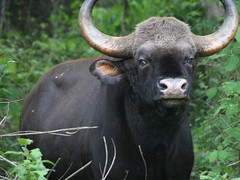
This black mongrel called Goonda still stands sentry at Jungle Retreat.

...and this weird tea maker that you will not find any where else but in Tamil Nadu still rules.
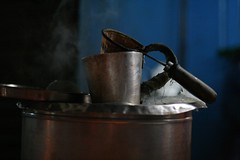

This black mongrel called Goonda still stands sentry at Jungle Retreat.

...and this weird tea maker that you will not find any where else but in Tamil Nadu still rules.

Thursday, May 06, 2010
Auto Wisdom
Social commentators have relied on several indicators to get a taste of the zeitgeist; google search trends, metro-station graffiti, twitter tags, lavatory engravings and so on. I think there's another neglected source that gives a pulse of my city; the slogans at the back of auto-rickshaws. Social indicators or not, they are bloody amusing and here's the first of what I hope to be a series.


Labels:
autos
Sunday, May 02, 2010
Solitary Reaper

He lives alone on a faraway farm, hedging his bets on an obscure system of agriculture called Analog Forestry. He's not quite a Christopher McCandless in his rejection of civilization as you're likely to find him bent over a laptop in his cozy little house that was built a full 150 yrs ago. His social isolation is also not total, for even today he was visited by a bunch of students that wanted his counsel on various projects that they were doing. Moreover, he's got a pet too, and a very unusual one at that; a charming old stray horse! Yet, there is some uncomfortably melancholic wisdom that hangs around him that almost makes me scared. The feeling is a simultaneous hybrid of "this is how it's meant to be" and its exact opposite. I have a feeling that my friend, LCN, is going to turn into a legend.

Subscribe to:
Posts (Atom)



